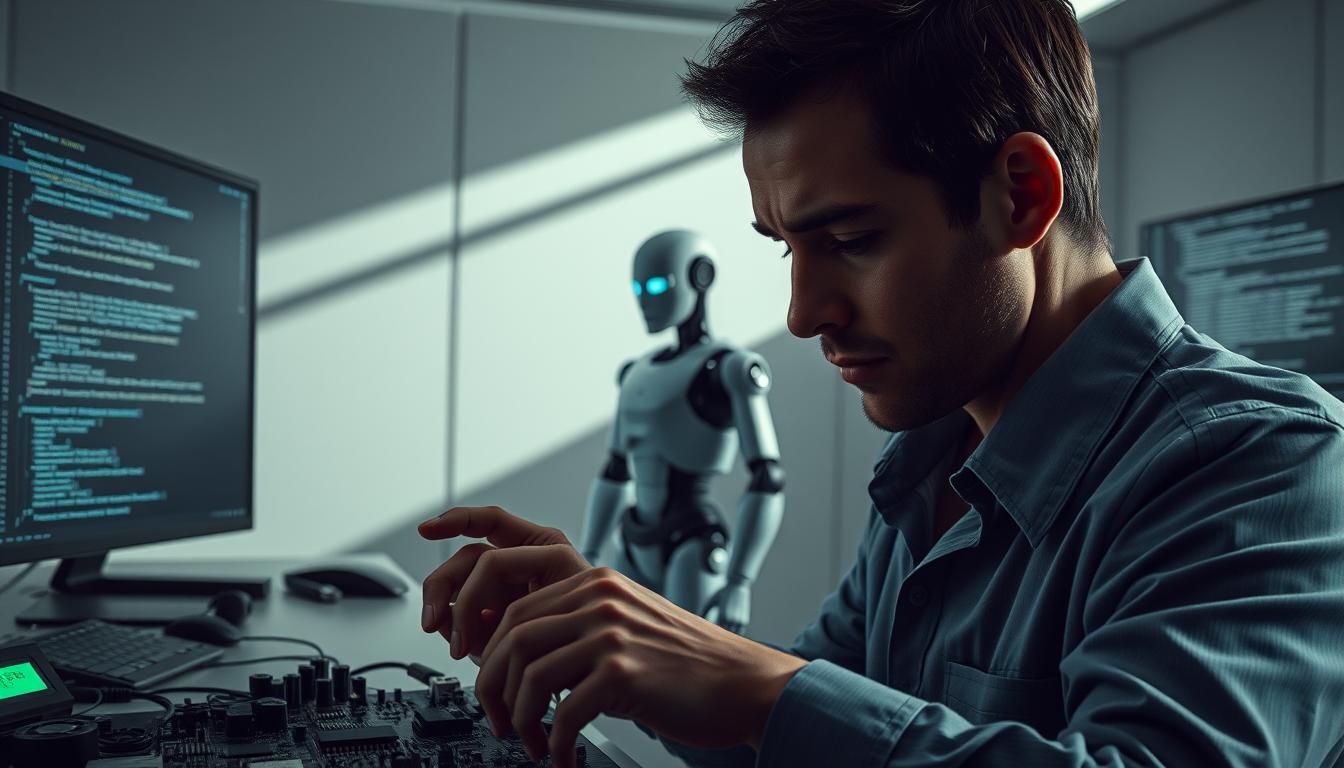Could your next favorite social media star be a digital being? Virtual influencers like Lil Miquela have 3 million Instagram followers. They mix animation with reality. Samsung’s NEON is another example of synthetic companions that seem real. But is this a technological revolution or just smart marketing?
A Pew Research study found 52% of Americans are uneasy about AI. Yet, virtual beings are becoming more popular. Brands spend over $15 billion a year on these digital characters. They use 3D scanning and speech synthesis to make them seem real.
These digital humans can laugh, empathize, and even talk about current events. From science fiction to reality, they challenge our view of authenticity online.
Key Takeaways
- Virtual influencers now command multimillion-dollar brand deals
- 87% of Gen Z consumers interact with synthetic personas weekly
- Motion capture tech enables 0.2-second emotional response mimicry
- Healthcare trials use virtual coaches with 92% patient compliance rates
- Ethical debates intensify as synthetic faces replace human models
While some see these digital beings as just high-tech puppets, others have a different view. Gartner predicts the virtual beings market will grow to $125 billion by 2035. They could change customer service and even psychotherapy. The big question is how they will change our connections in a world that’s becoming more artificial.
Understanding Digital Humans: What Are They?
Imagine talking to someone who looks and acts like a real person but isn’t. Digital humans are AI-powered beings that mimic human behavior. They use advanced tech to look and act like us, making interactions feel real.
Definition and Overview of Digital Humans
Digital humans are computer-generated characters powered by AI. They go beyond simple chatbots and static models. They understand context and adapt their responses through AI.
For example, Soul Machines creates AI avatars that mimic human eye contact and emotions.
These beings are great in three ways:
- Visual realism: Unreal Engine’s MetaHuman Creator makes faces look incredibly real
- Behavioral intelligence: NVIDIA’s Omniverse Avatar platform lets them make decisions in real-time
- Scalability: Platforms like Synthesia can create thousands of personalized videos every day
Key Technologies Behind Digital Humans
Four key innovations make digital humans possible:
- 3D Modeling Engines: MetaHuman Creator cuts down avatar creation time from weeks to hours
- Neural Networks: DeepMotion uses AI to animate body language that matches speech
- Voice Synthesis: Resemble AI can clone voices with 98% accuracy in under 10 seconds
- Cloud Rendering: NVIDIA’s Omniverse streams high-quality avatars to any device
As analysts say in Web3 studies, these techs are advancing quickly. Digital humans are already in customer service at places like Bank of America. Their potential is vast, beyond just scripted interactions.
Applications of Digital Humans Across Industries
Digital humans are changing how we work and play. They use augmented reality characters and avatar technology to solve problems we never thought possible. Let’s look at three areas where digital humans are making a big impact.
Entertainment: Revolutionizing Media and Content Creation
Epic Games’ MetaHuman Creator lets developers make realistic digital actors fast. Meta’s VR avatars can track eyes and show emotions, making social experiences feel real.
“We’re seeing 40% faster production timelines for studios using digital humans,”
reports a leading animation director.
Customer Service: Enhancing User Experience with AI
Bank of America’s Erica handles over 50 million client requests monthly. Mitsuku’s chatbot is 94% accurate in answering banking questions. The benefits are clear:
- 24/7 availability across time zones
- Consistent brand messaging
- Multilingual support capabilities
Healthcare: Support and Training Through Virtual Agents
Oxford Medical Simulation trains nurses with realistic scenarios. Woebot Health’s AI helps with therapy, showing 70% user engagement. The healthcare avatar market is expected to hit $10.2 billion by 2028 (Grand View Research).
| Industry | Key Technology | Impact Metric |
|---|---|---|
| Entertainment | Real-time rendering | 40% faster production |
| Banking | NLP algorithms | 50M+ monthly interactions |
| Healthcare | Emotion recognition | 70% engagement rate |
The Pros and Cons of Digital Humans
Digital humans are changing many fields, from healthcare to retail. They offer great benefits but also come with challenges. Let’s look at how these robot personalities bring innovation and risks together.

Benefits: Efficiency, Scalability, and Cost-Effectiveness
Digital humans excel where humans face limits. Systems like IBM Watson Assistant work non-stop, handling thousands of customer queries at once. The main benefits are:
- Reduced labor costs: No sick days or overtime pay
- Instant global deployment: Multilingual avatars need no visas
- Consistent performance: No errors due to fatigue
A recent analysis found companies using synthetic media agents see 40% faster responses and 35% higher customer satisfaction.
Challenges: Ethical Dilemmas and Technological Limits
Digital humans bring clear business benefits but also raise big questions:
“We’re creating entities that can mimic human empathy without truly feeling it. This gap could erode trust in all digital interactions.”
| Issue | Example | Impact |
|---|---|---|
| Deepfake Abuse | Fake CEO videos | Corporate fraud risk |
| Emotion Recognition | 65% accuracy in detecting sarcasm | Miscommunication |
| Job Displacement | World Economic Forum predicts 20% role automation by 2025 | Workforce retraining needs |
Current synthetic media tools struggle with complex tasks. Most emotion-detection systems get cultural facial expressions wrong 30% of the time, according to MIT studies.
The Future of Digital Humans in Society
Digital humans are changing faster than many thought. Microsoft Mesh lets people work together in virtual spaces with augmented reality characters. Neuralink is working on brain-computer interfaces that could change how we interact with avatars. These advancements suggest a future where digital twins are part of our everyday lives.
Predictions: Trends and Innovations on the Horizon
The market for digital humans is expected to grow from $10 billion to $530 billion by 2030. This growth is thanks to AI-generated avatars that can be made in just 15 minutes. With 5G and quantum computing, we’ll see more realistic customer service and AI in medicine.
By 2025, 63% of millennials want to use platforms like the Metaverse to create their own digital personas. This shows how digital humans are becoming a big part of our lives.
The Human-AI Relationship: Coexistence or Competition?
Sophia the Robot’s citizenship in Saudi Arabia raised questions about AI rights. As digital humans become more like us, we’ll face more questions about privacy and bias. AI is making tasks like telemedicine consultations easier, but it also raises concerns about job loss in creative fields.
Gartner’s Hype Cycle says we need to balance innovation with trust for digital humans to become mainstream. As brain-computer interfaces improve, we’ll see a closer connection between humans and machines. The question is, will we see digital humans as partners or competitors? The answer will shape our future.
FAQ
Are digital humans real technology or just science fiction?
Digital humans are real tech, not just sci-fi. Lil Miquela, with 3M Instagram followers, and Samsung’s NEON show their use. Pew Research says 52% of Americans use AI monthly, proving they’re real.
What core technologies power digital humans?
Key techs include Unreal Engine’s MetaHuman Creator for detailed 3D models. NVIDIA Omniverse Avatar handles AI interactions. Synthesia creates videos, and Soul Machines uses AI for emotions.
How are digital humans transforming customer service?
A: Bank of America’s Erica handles 50M+ client chats yearly with NLP. Mitsuku solves tough questions. The global conversational AI market is expected to hit .6B by 2030.
What ethical concerns surround digital human technology?
Concerns include deepfake misuse and identity theft. Replika can manipulate emotions. The World Economic Forum says 43% of businesses lack ethical AI rules.
Can digital humans achieve true emotional intelligence?
Systems like Woebot Health show basic empathy. But MIT studies say they don’t understand context like humans. Affectiva’s AI is 80% accurate in controlled settings, but struggles with cultural differences.
What future innovations will shape digital humans?
New trends include Microsoft Mesh for holographic work and Neuralink-style brain interfaces. Gartner says 25% of companies will try digital employee twins by 2026. Debates on Sophia the Robot‘s rights are ongoing.
How do virtual influencers impact marketing industries?
CGI influencers like Lil Miquela and Noonoouri have big deals with brands. They get 3x more engagement than real influencers, says HypeAuditor. But the FTC now requires #virtualinfluencer labels for ads.





